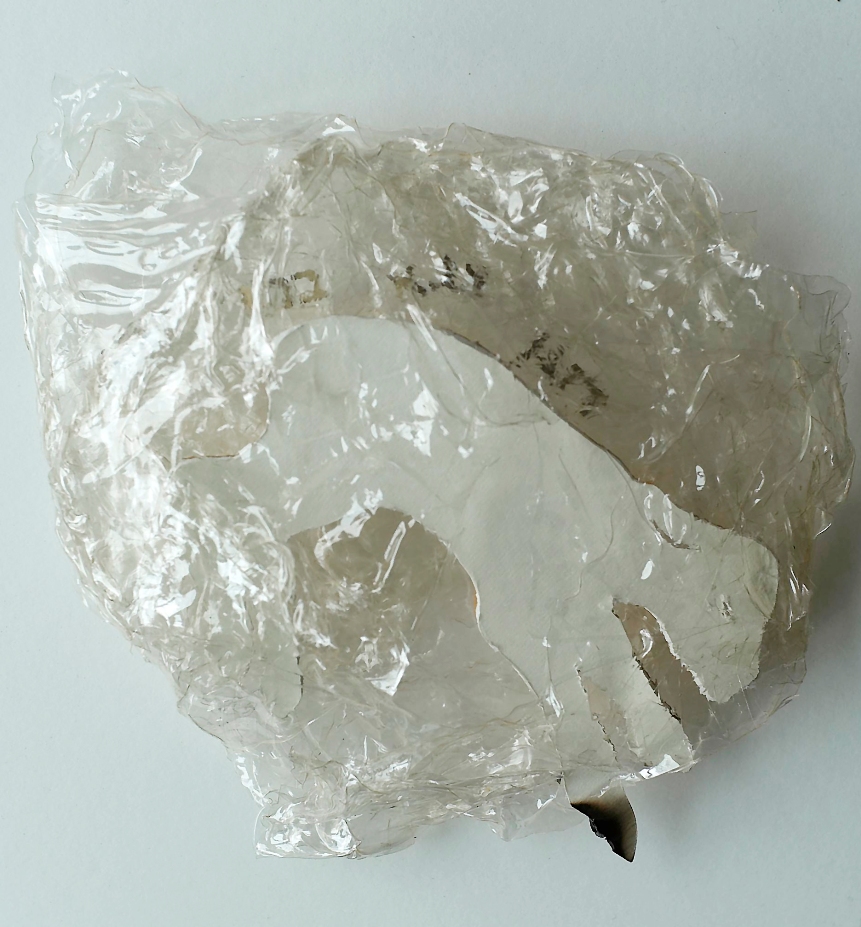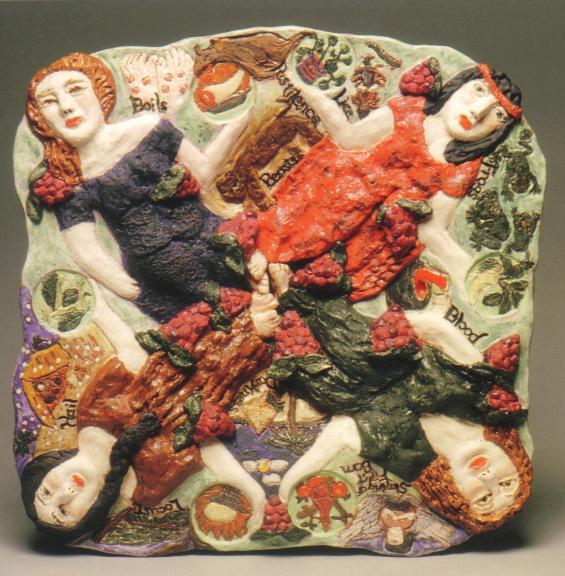The Seder table symbols and rituals are the props for the Haggadah script. Imaginative improvisation is necessary to reveal their secrets…
Had Gadia
This sculpture is based on a modern reworking of the traditional Pessach song “Had Gadia” by Hava Halberstein, an Israeli song writer. Although the song recounts the cycle of suffering by living things, at the end, it provides comfort that GOD can smite even the all powerful angel of death. In that context, Hava Halberstein decided to use the song to make a powerful attack on on militarism, suppression, everything that is opposite to freedom. The majority of the song is a simple Hebrew rendition of the Aramaic; however, as she arrives at the following verse, her voice rises to a fierce dramatic intensity as if to better convey her rage at the injustice committed everywhere.
….“That on all nights, all other nights, I asked only Four Questions
This night I have another question:
“How long will the cycle of violence continue?”
Chase and be chased, beat and be beaten,
When will this madness end?
How have I changed, how are you different?
I changed this year
I was once a sheep and a tranquil kid
Today I’m a tiger and a ravishing wolf
I was once a dove and I was a deer
Today I don’t know who I am.
Billha Zussman
Amsterdam, Netherlands
www.billha.com
No Bread, No Freedom
This artwork is a response to an NPR interview with author Blaine Harden about his book Escape from Camp 14. Camp 14 is the story of a young man who escapes a labor camp because he was hungry.
There are labor camps in North Korea estimated to hold 150,000-200,000 people. The people are given meager rations of 800 calories per day. There are generations of families living in these camps. The hunger is so great that the ties that bind parents to their children have been broken. Parents beat their children when the children take food from them.
I heard in this story the echoes of a people enslaved in Egypt for 400 years, oppressed and afflicted families, threatened with the killing of their newborn sons.
This matzah cover reminds us that freedom was given to families. Just as the ancient Israelites families ate together on the night be the exodus, we also eat together as families at the seder table. The unity of the family exists together with the unity of the people.
During the Passover seder we raise 3 fragile matzahs, recognizing the fragile beginnings of a new society (Kohanim, Levites, and all others) and we say “Let all who are hungry to come and eat.” Painted across the three matzahs is the morning blessing “Blessed art Thou, Lord our G-d, King of the Universe who has not made me a slave.” Near the matzahs is an unfinished matzah cover because freedom and Passover are always works in progress.
Naomi Fishman with the help of Sunny Brodsky
St. Louis, Missouri and Avon, Colorado
Afikoman
I was brought up with the aspirations of Zionism- to build a state where every Jew could be and would be equal and every Jew would be welcomed. It was my strongest connection to Judaism- more than religion, more than tradition. Then I came to know that Jews discriminate against other Jews and those Arab inhabitants of the Land were chase away to become slaves, almost like we ourselves were in Egypt. Today there is such a gap in poverty and richness. To me this is not a matter of money or possession. It is cultural and spiritual poverty. Money makes one greedy and forget the essential values in life. We forgot the “we” that had been enslaved in many Egypts and found the “me” that was freedom.
Therefore the chad gadia is stuck. Its burned leg, the one-time Passover offering at the Temple, now symbolizes the spiritual values overcome by short term satisfaction. The afikoman is the part of the broken matzah and must be returned to the seder table to remind us that we are only complete when we are together.
Suzanna Grünfeld
Amsterdam, Netherlands
Women’s Seder Plate
My seder plate, sculpted in terra cotta clay, was specifically made for a Women’s Seder. The Women’s Seder is a special time during Passover when women share stories about their liberation, and a time to rest and recline as free women. Mothers, daughters, grandmothers and aunts, or a group of women friends join together as a family of women.
Our foremothers are also gathered in spirit at the Seder table. We speak of Deborah, our mother – of all of our mothers whose strength, courage and faith in God enabled us to reach this moment in time.
I carved the “Ten Plagues” into my seder plate because they represent a necessary part in the liberation of Jews from slavery. Today, we can consider “Ten Opportunities” facing us as Jewish women. I’d like to share a few of those opportunities with you:
• to value women of all ages involved in the Jewish as well as secular world.
• to recognize our evolving roles as women in an effort to change past rigid roles and stereotypes.
• to honor leadership dedicated to helping men and women affect change for all of the opportunities of Jewish womanhood.
As we open the door for Miriam, the prophetess, we open the door of hospitality and friendship – as a sign that no woman is shut off from other human beings, and as a symbol for all women who are going forth with dignity and pride into the making of a Jewish future for all of our people.
The spirit and talents of all women participating in the Women’s Seder make this gathering a fulfilling moment in time.
Sandy Kaplan
St. Louis, Missouri
www.sandykaplansculptuor.blogspot.com
Miriam and the Tambourine
And Miriam the prophetess, Aaron’s sister, took a drum in her hand, and all the women went out behind her with drums and with dances.
And Miriam sang to them: Sing to G-d for G-dd triumphed! Horse and his rider G-d cast into the sea. (Exodus 15:20-21)
Miriam utilized music and dance at a critical moment in the Exodus account as the water of the Red Sea submerges Pharaoh and his army and as the Israelites cross onto dry land. As depicted on my matzah cover, Miriam’s spontaneous creative expression symbolizes the newly acquired freedom for the Israelites from centuries of slavery under Egyptian masters.
Miriam understands that freedom is just as much a physical experience as a psychological one. In order for the Israelites to truly feel like a free people after years of Egyptian oppression, they must actively pursue freedom through many outlets: intellectual, creative and spiritual. The physical cessation of slavery will not be enough to turn an enslaved people into a free one.
Through the creative expressions of song and dance, Miriam and the Israelite women begin to lead the way for their people’s long and protracted journey into freedom.
Berta Goldgaber
St. Louis, Missouri
www.judaicafabricart.com
Freedom From Phantom Pain
“And in this labyrinth where night is blind, the phantom of the opera, here in my mind…”
These lyrics from Andrew Lloyd Weber’s “Phantom of the Opera” must have haunting resonance to people suffering from phantom pains. Phantom pain refers to the severe pain a person feels from a limb which no longer exists. The amputation exists in the mind, as if it were still a part of the body. Neuroscientists have figured out how to exorcise this phantom for some patients.
This is a box which my patient built. He inserts his left hand with several amputated fingers into the enclosed chamber. He inserts his normal right hand into the fully exposed chamber which has a mirror that creates a mirrored image of a “normal left hand”. My patient is now free of phantom pain.
Norman Fishman
St. Louis, Missouri




0 Comments